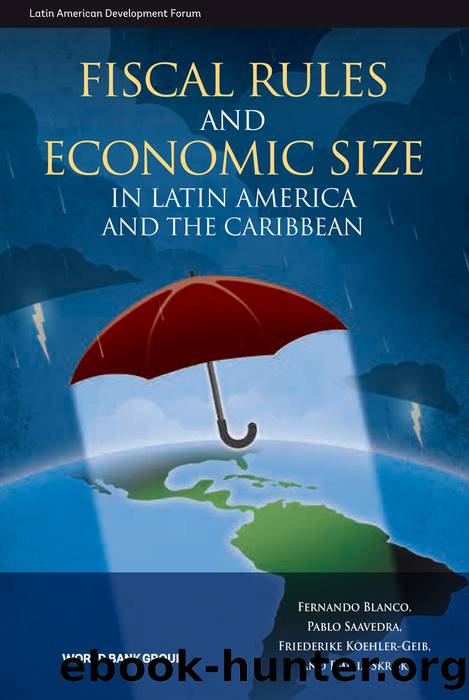Fiscal Rules and Economic Size in Latin America and the Caribbean by Fernando Blanco Pablo Saavedra Friederike Koehler-Geib & Emilia Skrok

Author:Fernando Blanco, Pablo Saavedra, Friederike Koehler-Geib & Emilia Skrok
Language: eng
Format: epub
References
Aguiar, Mark, and Gita Gopinath. 2007. âEmerging Market Business Cycles: The Cycle Is the Trend.â Journal of Political Economy 115 (11): 69â102.
Aguirre, Alvaro. 2017. âWelfare Effects of Fiscal Rules with Heterogeneous Agents in Small Open Economies.â Background paper, World Bank, Washington, DC. http://documents.worldbank.org/curated/en/299961597691885453/Welfare-Effects-of-Fiscal-Rules-with-Heterogeneous-Agents-in-Small-Open-Economies.
Auffret, Philippe. 2003. âHigh Consumption Volatility: The Impact of Natural Disasters?â Policy Research Working Paper 2962, World Bank, Washington, DC.
Bry, Gerhard, and Charlotte Boschan. 1971. âCyclical Analysis of Time Series: Selected Procedures and Computer Programs.â NBER Technical Paper 20, National Bureau of Economic Research, Cambridge, MA.
Calderón, César, and Rodrigo Fuentes. 2010. âCharacterizing the Business Cycles of Emerging Economies.â Policy Research Working Paper 5343, World Bank, Washington, DC.
Cavallo, Eduardo, and Ilan Noy. 2009. âThe Economics of Natural Disasters: A Survey.â IDB Working Paper 124, Inter-American Development Bank, Washington, DC.
CRED (Centre for Research on the Epidemiology of Disasters). Various years. EM-DAT: The OFDA/CRED International Disaster database. Brussels: Catholic University of Leuven, Leuven.
Dumienski, Zbigniew. 2014. âMicrostates as Modern Protected States: Towards a New Definition of Micro-Statehood.â Occasional Paper, Institute of International Affairs, Centre for Small States Studies, University of Auckland, Auckland.
Easterly, William, and Aart Kraay. 2000. âSmall States, Small Problems? Income, Growth, and Volatility in Small States.â World Development 28 (11): 2013â27.
Favaro, Edgardo. 2008. Small States, Smart Solutions: Improving Connectivity and Increasing the Effectiveness of Public Services. Direction in Development: Public Sector Governance. Washington, DC: World Bank.
Favaro, Edgardo. 2017. âBenefits and Costs of Implementing Fiscal Rules in Small States.â Background paper, World Bank, Washington, DC.
Harding, Don, and Adrian Pagan. 2002. âDissecting the Cycle: A Methodological Investigation.â Journal of Monetary Economics 49 (2): 365â81.
Hnatkovska, Viktoria, and Friederike Koehler-Geib. 2018a. âCharacterizing Business Cycles in Small Economies.â Policy Research Working Paper 8527, World Bank, Washington, DC. http://documents.worldbank.org/curated/en/556931531406770669/pdf/WPS8527.pdf.
Hnatkovska, Viktoria, and Friederike Koehler-Geib. 2018b. âSources of Volatility in Small Economies.â Policy Research Working Paper 8526, World Bank, Washington, DC. http://documents.worldbank.org/curated/en/412821531405512576/pdf/WPS8526.pdf.
IMF (International Monetary Fund). Various years. World Economic Outlook. Washington, DC: IMF.
IMF (International Monetary Fund). Various years. International Financial Statistics database. Washington, DC: IMF.
Lederman, Daniel, and Justin Lesniak. 2017. âOpen and Nimble: Finding Stable Growth in Small Economies.â Regional Studies, Office of the Chief Economist for the Latin America and the Caribbean Region, World Bank, Washington, DC.
Male, Rachel. 2010. âDeveloping Country Business Cycles: Revisiting the Stylized Facts.â Working Paper 664, School of Economics and Finance, Queen Mary University of London.
Neumeyer, Pablo A., and Fabrizio Perri. 2005. âBusiness Cycles in Emerging Economies: The Role of Interest Rates.â Journal of Monetary Economics 52 (2): 345â80.
Raddatz, Claudio. 2007. âAre External Shocks Responsible for the Instability of Output in Low-Income Countries?â Journal of Development Economics 84 (1): 155â87.
Rand, John, and Finn Tarp. 2002. âBusiness Cycles in Developing Countries: Are They Different?â World Development 30 (12): 2071â88.
World Bank. Various years. World Development Indicators database. Washington, DC: World Bank.
Download
This site does not store any files on its server. We only index and link to content provided by other sites. Please contact the content providers to delete copyright contents if any and email us, we'll remove relevant links or contents immediately.
International Integration of the Brazilian Economy by Elias C. Grivoyannis(91267)
The Radium Girls by Kate Moore(11921)
Turbulence by E. J. Noyes(7936)
Nudge - Improving Decisions about Health, Wealth, and Happiness by Thaler Sunstein(7615)
The Black Swan by Nassim Nicholas Taleb(7010)
Rich Dad Poor Dad by Robert T. Kiyosaki(6405)
Pioneering Portfolio Management by David F. Swensen(6226)
Man-made Catastrophes and Risk Information Concealment by Dmitry Chernov & Didier Sornette(5921)
Zero to One by Peter Thiel(5686)
Secrecy World by Jake Bernstein(4646)
Millionaire: The Philanderer, Gambler, and Duelist Who Invented Modern Finance by Janet Gleeson(4376)
The Age of Surveillance Capitalism by Shoshana Zuboff(4210)
Skin in the Game by Nassim Nicholas Taleb(4162)
Bullshit Jobs by David Graeber(4095)
The Money Culture by Michael Lewis(4076)
Skin in the Game: Hidden Asymmetries in Daily Life by Nassim Nicholas Taleb(3929)
The Dhandho Investor by Mohnish Pabrai(3699)
The Wisdom of Finance by Mihir Desai(3654)
Blockchain Basics by Daniel Drescher(3507)
